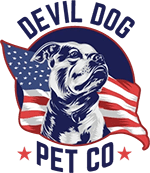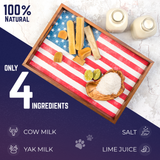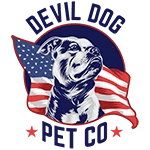Key Takeaways
- Cheese treats for dogs serve as high-value rewards that enhance training sessions.
- These treats are rich in protein, making them both tasty and nutritious.
- Options range from single-ingredient yak cheese chews to homemade cheese biscuits.
- Cheese treats can be used for quick reinforcement or provide long-lasting dental benefits.
Table of Contents
- The Devil Dog Guide to Cheese Treats for Dogs
- Cheese Treats for Dogs, Science, Benefits & Risks
- How to Safely Give Cheese Treats to Your Dog
- Commercial Cheese Treats, What Separates Quality from Junk
- Commercial Cheese Treats: Feature-by-Feature Breakdown
- Homemade vs. Store-Bought: The Leadership Decision
- Cheese vs. Other Popular Dog Treats, What's the Difference?
- Troubleshooting Common Cheese Treat Challenges
- Premium Cheese Chews: Devil Dog vs. Competitors
- Leading with the Right Cheese Treats
The Devil Dog Guide to Cheese Treats for Dogs
Cheese treats dogs crave aren't just tasty rewards, they're high-value training tools that can transform your leadership sessions. These protein-packed snacks range from single-ingredient yak cheese chews to homemade cheese biscuits, offering everything from quick training reinforcement to long-lasting dental benefits.
At Devil Dog Pet Co., we've watched countless owners struggle with unmotivated pups during training. The right cheese treat changes the game, suddenly, your dog's focus locks on you like a Marine following orders. But here's the catch: not all cheese treats are created equal, and the wrong choice can derail your leadership faster than you can say "sit." For dogs who need an extra challenge, the Beast Himalayan Dog Chew is an excellent option for power chewers.
If you're looking for a longer-lasting reward, Monster Himalayan Dog Chew - 3 Pack provides extended chewing satisfaction and is ideal for larger breeds or multi-dog households.
Quick Answer: What Makes Cheese Treats Effective?
Cheese treats combine high protein content (5-9g per ounce) with irresistible aroma and taste. The key is choosing lactose-reduced options like aged cheddar or yak cheese, portioning correctly (under 10% of daily calories), and using them strategically for training breakthroughs.
Cheese Treats for Dogs, Science, Benefits & Risks

Why Cheese Fires Up Your Dog's Motivation
Dogs respond to cheese because it hits multiple reward centers simultaneously. The casein proteins and milk fats trigger powerful palatability responses, while the strong aroma cuts through distractions better than bland kibble. Even picky eaters who ignore standard treats will lock onto quality cheese, it's biological programming at work.
Nutritional Profile, The Good and the Watch-Outs
Quality cheese treats for dogs deliver impressive nutritional density. Cheddar provides 7 grams of protein per ounce plus calcium for bone health. Yak cheese amps this up to 9 grams protein while being naturally lactose-reduced through traditional aging processes.
| Cheese Type | Protein (per oz) | Fat Content | Lactose Level | Best Use |
|---|---|---|---|---|
| Yak Cheese | 9g | Low | Minimal | Long-lasting chews |
| Cheddar | 7g | Moderate | Low | Training rewards |
| Cottage Cheese | 4g | Very Low | Moderate | Sensitive stomachs |
| Mozzarella | 6g | Moderate | Low | Homemade treats |
The risks? Lactose intolerance affects roughly 65% of adult dogs to varying degrees. Signs include loose stools, gas, or vomiting within 2-12 hours of consumption. High-sodium processed cheeses can spike blood pressure, while moldy varieties like blue cheese contain mycotoxins that are toxic to dogs. For a deeper dive into the science and safety of cheese treats, read this guide on natural yak cheese chew treats for dogs.
Safe vs. Dangerous Cheese Choices
Green light: Aged cheddar, cottage cheese, yak cheese, mozzarella, and Swiss, all naturally lower in lactose and free from dangerous additives.
Red flag: Blue cheese, Roquefort, brie, and processed cheese slices. The blue-veined varieties contain roquefortine C, which causes vomiting and seizures in dogs. Processed slices pack excessive sodium and artificial preservatives that stress kidneys over time.
How to Safely Give Cheese Treats to Your Dog
The "Start Low, Go Slow" Protocol
Begin with a pea-sized piece once daily, then monitor for 24 hours. No digestive upset? Gradually increase to training-appropriate portions, thumbnail-sized for small dogs, quarter-sized for large breeds. For puppies over 10 weeks, halve these amounts and supervise closely.
During training sessions, deliver cheese treats within one second of the correct behavior. This timing locks in the reward association and maximizes learning speed, a principle we've proven countless times with rescue dogs who needed confidence rebuilds.
Problem Prevention and Quick Fixes
Soft stools or gas after cheese treats? Cut the serving size in half and skip a day. Most dogs adapt within a week once their digestive systems adjust to the new protein source. Persistent symptoms mean that dog needs lactose-free alternatives, switch to yak cheese or eliminate dairy entirely. For more on the benefits of yak cheese, explore this yak cheese article.
True allergic reactions involve itching, swelling, or respiratory distress, this requires immediate vet attention and permanent cheese elimination from that dog's diet.
Commercial Cheese Treats, What Separates Quality from Junk
Devil Dog Himalayan Yak Cheese Chews - The Gold Standard
Best for: Power chewers and dogs with dairy sensitivities
Devil Dog's Himalayan Yak Cheese Chews represent the pinnacle of natural cheese treats dogs deserve. Crafted from yak and cow milk in Nepal's highlands, these single-ingredient powerhouses deliver protein-packed satisfaction without artificial preservatives or chemicals.
Key Advantage: Naturally lactose-free through traditional 4-week drying process, making them safe for dairy-sensitive dogs while providing 15+ grams of protein per ounce.
These chews outlast standard cheese biscuits by weeks, not hours. The dense composition forces slow grinding that naturally scrapes plaque while releasing endorphins through extended chewing sessions. When your dog reaches the final nub, microwave it for 45 seconds to create a crunchy cheese puff, zero waste, maximum value. For this final step, try Himalayan Dog Chew Nuggets for Making Yak Chew Cheese Puffs for a fun and safe treat transformation.
Commercial Cheese Biscuit Options
Best for: Training rewards and quick motivation
Mass-market cheese biscuits offer convenience but sacrifice nutritional density. Most contain wheat flour as the primary ingredient, relegating cheese to a flavoring agent rather than the main protein source.
Pros:
- Readily available at pet stores
- Consistent sizing for training
- Lower cost per unit
Cons:
- High carbohydrate content from grain fillers
- Artificial preservatives and colorants
- Short-lived entertainment value
Freeze-Dried Cheese Treats
Best for: High-value training and travel
Freeze-dried cheese maintains nutritional integrity while creating lightweight, shelf-stable treats. The process removes moisture without heat damage, preserving natural enzymes and concentrated flavor that drives even stubborn dogs to focus.
These treats excel as jackpot rewards during recall training or as pill pockets for medication. However, their crumbly texture creates mess, and the premium processing drives costs significantly higher than traditional options.
Commercial Cheese Treats: Feature-by-Feature Breakdown

| Feature | Devil Dog Yak Chews | Commercial Biscuits | Freeze-Dried Cheese |
|---|---|---|---|
| Primary Ingredient | Yak/cow milk (single ingredient) | Wheat flour + cheese powder | Pure cheese |
| Protein Content | 15+ grams per ounce | 3-5 grams per ounce | 12-14 grams per ounce |
| Duration | 2-4 weeks for moderate chewers | Minutes per treat | Seconds per piece |
| Dental Benefits | Plaque scraping through grinding | Minimal abrasive action | None (dissolves quickly) |
| Mess Factor | Virtually none | Crumbs and fragments | Powder residue |
| Lactose Content | Less than 0.1% (naturally processed) | Variable (often higher) | Concentrated (potential sensitivity) |
The comparison reveals why experienced dog owners gravitate toward single-ingredient options. While commercial biscuits serve specific training functions, they lack the sustained engagement and nutritional density that cheese treats dogs need for optimal health and behavior management. For a curated selection, explore our long-lasting dog chews for dogs who need more than a quick snack.
Homemade vs. Store-Bought: The Leadership Decision
Complete Ingredient Control
Homemade cheese treats deliver unmatched transparency, you select every ingredient, control sodium levels, and eliminate preservatives that trigger sensitivities. A basic recipe combining shredded cheddar, oat flour, and eggs creates protein-rich rewards tailored to your dog's specific needs.
The process demands time investment: mixing, rolling, cutting, and baking require 45-60 minutes plus cooling time. Storage becomes critical, homemade treats lack preservatives, limiting shelf life to 5-7 days refrigerated or 3 months frozen. For more on healthy homemade and natural options, see this guide to healthy yak chews for dogs.
Commercial Reliability
Quality commercial cheese treats dogs offer batch consistency and extended shelf life through controlled manufacturing processes. Premium brands like Devil Dog maintain strict sourcing standards and third-party testing that individual kitchens cannot replicate. If you want a reliable, extra-large option, check out the Extra Large (XL) - Himalayan Dog Chew for maximum satisfaction.
The trade-off involves ingredient complexity, even quality commercial treats contain multiple components for texture, preservation, and palatability. However, this complexity often enhances digestibility and nutritional balance compared to simple homemade versions.
Cheese vs. Other Popular Dog Treats, What's the Difference?
Understanding how cheese treats dogs stack up against other popular options helps you choose the right tool for every training scenario. Each treat type serves distinct purposes in your leadership arsenal.
| Treat Type | Protein (per oz) | Fat Content | Digestibility | Longevity | Best Use Case |
|---|---|---|---|---|---|
| Cheese Treats | 5-7g | 6g | High | Short | Training rewards, pill pockets |
| Yak Chews | 9g | 2g | Complete | Weeks | Mental stimulation, dental health |
| Bully Sticks | 9g | 3g | Complete | Hours | Power chewers, solo time |
| Peanut Butter Treats | 4g | 8g | High | Minutes | High-value rewards, puzzle toys |
Cheese treats excel as instant-gratification training tools. Their strong aroma and creamy texture make them ideal for focus work and recall training. However, for sustained chewing sessions that promote dental health, yak chews deliver superior value and safety. For more on the science behind treat selection, see this peer-reviewed study on canine nutrition and treats.
Leadership Strategy: Rotate treat types based on training goals. Use cheese for precision work, yak chews for enrichment, and bully sticks for high-energy outlets. This variety prevents habituation and maintains motivation.
Troubleshooting Common Cheese Treat Challenges

Managing Lactose Sensitivity
Approximately 65% of adult dogs show some degree of lactose intolerance. Signs include loose stools, gas, or stomach upset within 2-6 hours of consumption. Start with aged cheeses like cheddar or Swiss, which contain minimal lactose due to the aging process.
For severely sensitive dogs, yak chews offer the cheese flavor profile without lactose concerns. The traditional 4-week drying process eliminates nearly all lactose, leaving only trace amounts below 0.1%. For a variety of sizes, browse our large Himalayan dog chews for the perfect fit for your pet.
Preventing Overindulgence
Cheese treats should comprise no more than 10% of your dog's daily caloric intake. For a 50-pound dog consuming 1,200 calories daily, limit cheese treats to 120 calories, roughly 1.5 ounces of cheddar or one medium yak chew per day.
Monitor body condition monthly. If you can't easily feel your dog's ribs, reduce treat portions and increase exercise intensity.
Resource Guarding Prevention
High-value cheese treats can trigger competition in multi-dog homes. Separate dogs during cheese treat sessions, using crates or different rooms. This prevents resource guarding while ensuring each dog receives appropriate portions.
Train a "wait" command before distributing treats, establishing your leadership role in resource allocation. For additional insights on treat safety and best practices, review this veterinary guide to treats and chews.
Premium Cheese Chews: Devil Dog vs. Competitors
Devil Dog Himalayan Yak Chews - Veteran-Standard Quality
Best for: Power chewers, dogs with beef allergies, extended mental stimulation
Devil Dog sources directly from Nepalese village cooperatives, ensuring authentic traditional processing. Each chew undergoes dual inspection, overseas testing plus in-house quality control at our Michigan facility. The 4-week smoking and drying process creates a virtually odorless, mess-free chew that can occupy aggressive chewers for weeks. For those seeking a multi-pack, the Large - Himalayan Dog Chew - 3 Pack is a convenient and cost-effective choice.
Market Alternatives
Most commercial yak chews lack transparent sourcing and consistent quality control. Many competitors use accelerated drying methods that compromise texture and longevity. Others source from factory farms rather than traditional cooperatives, reducing both authenticity and sustainability.
Devil Dog Advantages:
- Dual quality inspection system
- Traditional 4-week processing
- Direct cooperative sourcing
- 30-day satisfaction guarantee
- Veteran-owned transparency
The difference shows in durability and safety. Devil Dog yak chews maintain structural integrity throughout the chewing process, wearing down gradually rather than splintering or breaking into dangerous chunks.
Leading with the Right Cheese Treats
Effective cheese treats dogs respond to aren't just snacks, they're leadership tools that strengthen your bond while supporting training goals. Whether you choose homemade cheese biscuits for daily rewards or premium yak chews for long-lasting enrichment, your commitment to quality and moderation sets the standard for Extreme Dog Leadership. Remember: the right treat, given at the right time, transforms training from a chore into a shared victory. Lead boldly, reward wisely, and keep your dog's tail wagging with every session.
Frequently Asked Questions
What types of cheese treats are safest and most beneficial for dogs with lactose intolerance?
Lactose-intolerant dogs do best with cheese treats that have minimal lactose, such as aged cheddar, Parmesan, or yak cheese chews, which undergo processes that reduce lactose content. These options provide protein and flavor without upsetting sensitive stomachs when given in moderation.
How can cheese treats be effectively incorporated into dog training sessions without overfeeding?
Use small, low-calorie cheese pieces as high-value rewards during short, focused training bursts. Keep total cheese calories under 10% of your dog’s daily intake and balance treats by adjusting meal portions to maintain healthy weight and energy.
What are the key differences between homemade cheese treats and commercial cheese treats for dogs?
Homemade cheese treats offer full control over ingredients and portion size, allowing customization for your dog’s needs, while commercial treats provide convenience, consistent quality, and often specialized formulations like lactose-reduced yak cheese chews. Both can be effective when chosen and used responsibly.
Are there any risks associated with feeding dogs certain types of cheese, such as blue cheese or processed varieties?
Yes. Blue cheese contains roquefortine C, which can be toxic to dogs, and processed cheeses often have additives, high sodium, or preservatives that may cause digestive upset or health issues. Stick to natural, low-lactose cheeses and avoid moldy or heavily processed varieties for safety.






